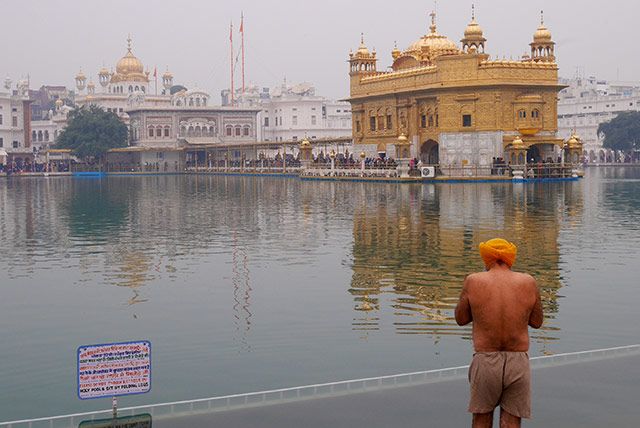Free and easy travel to northern India in December 2018 with my travel buddy ... Weather was cooling in the morning and evening; light jacket is required. Overall, it was dry and pleasant to walk around.
Do click here to view photos for the highlights of the travel, courtesy of yours truly, KC Leong.
Taj Mahal, Agra – the tomb for the Mughal emperor, Shah Jahan, and his favourite wife. I saw one advertisement long time ago ... Via-Agra (viagra): Man's greatest erection for love. This ivory structure is one of the seven wonders of the world.
There are many signage showing "Incredible India". We were amused by the slogan. A lot of things are possible in India; for example, all the cities are very dusty; the roads are lined with "landmines" ... a lot of cow dungs; the Indians honk wildly at every moment when driving; most of the time, the deafening sound of horn is from the motorbikes. At a junction, they would jam themselves up with the traffic with everyone or every vehicle going in all direction – they would then manoeuvre and clear the jam amicably.
The Indians are very patient and tolerant. One evening, while travelling in an auto-rickshaw (three-wheelers taxi or tuk-tuk), the tuk-tuk stopped in front of a crowd blocking the way. I saw the driver was smiling and talking to the crowd and they responded apologetically. I asked: “were they your friends?” He said, "big brothers, please let me pass" ... and they did.
Agra Fort, Agra – the main residence of the emperors of the Mughal Dynasty
On food – it is very easy to get diarrhea, even when eating their curry. The popular food "nasi biryani" is nice but very spicy and hot; one could also get diarrhea with the biryani rice. Eating out in restaurants was a problem. Walking around the areas where we stayed in most of the places, we could not find food for breakfast. At sight-seeing locations, we could not find restaurants for food either. So we only eat biscuits or apple for lunch. Most of the days, we eat only one proper meal. During long-distance train ride, though there were food vendors (who hopped on and off the train), we were not too adventurous to eat with unknown source. There was one long-distance train ride where I ate biscuits for lunch and dinner.
Drinking water – it is safer to drink from bottled water; 2 litres cost 30 Rupees (about RM1.80). Avoid drinking water pour from a jug into the glass in a restaurant: that could be tap water (this was told to me by Dr Kogulan, a hiker friend).
Qutb Minar and its Monuments, New Delhi – one of the finest monuments in India
Inter-town Transport – the most efficient mode is still the train services from Indian Railway. However, online booking by foreigners (say, from Kuala Lumpur) is a pain. The moment we input our local mobile telephone number, the registration transaction is terminated. Train ride from Lucknow to Amritsar – train delayed by 15 hours: we sat in the same restaurant, same seats for lunch, then dinner, then supper, then breakfast waiting for the train to arrive; while the entire lobby of the railway station was full of people sleeping on the floor.
Upon returning to Kuala Lumpur, I lost 5kg of weight; acquired a bad cough that I speculate that could be caused by the dusty environment during travelling.
Upon returning to Kuala Lumpur, I lost 5kg of weight; acquired a bad cough that I speculate that could be caused by the dusty environment during travelling.
Lotus Temple, New Delhi – Notable for its flower-like shape, the Lotus Temple is a prominent attraction in the city; open to all, regardless of religion or any other qualification.
Red Fort, New Delhi – the main residence of the emperors of the Mughal dynasty for nearly 200 years
India Gate, New Delhi – a memorial to 70,000 soldiers of the British Indian Army who died during the First World War
Akshardham Temple, New Delhi – a Hindu temple and a spiritual-cultural campus displaying millennia of traditional Hindu and Indian culture, spirituality, and architecture.
Ambedkar Memorial Park, Lucknow – the park honors the lives and memories of all those who've devoted their life for humanity, equality and social justice.
Golden Temple, Amritsar – built around a man-made pool, it is the holiest and the most important pilgrimage site of Sikhism
Vulture Peak, Bodhgaya – A small mountain just outside the ancient city of Rajgir is Buddha’s favorite retreat. It is so named because it resembles a sitting vulture with its wings folded.
Ghats by the Ganges River, Varanasi – riverfront steps leading to the banks of the River Ganges. Most of the ghats are bathing and puja ceremony ghats; the two burning ghats are used exclusively as cremation sites where the majority of dead bodies are cremated in Varanasi.
Posted by KC Leong











No comments:
Post a Comment